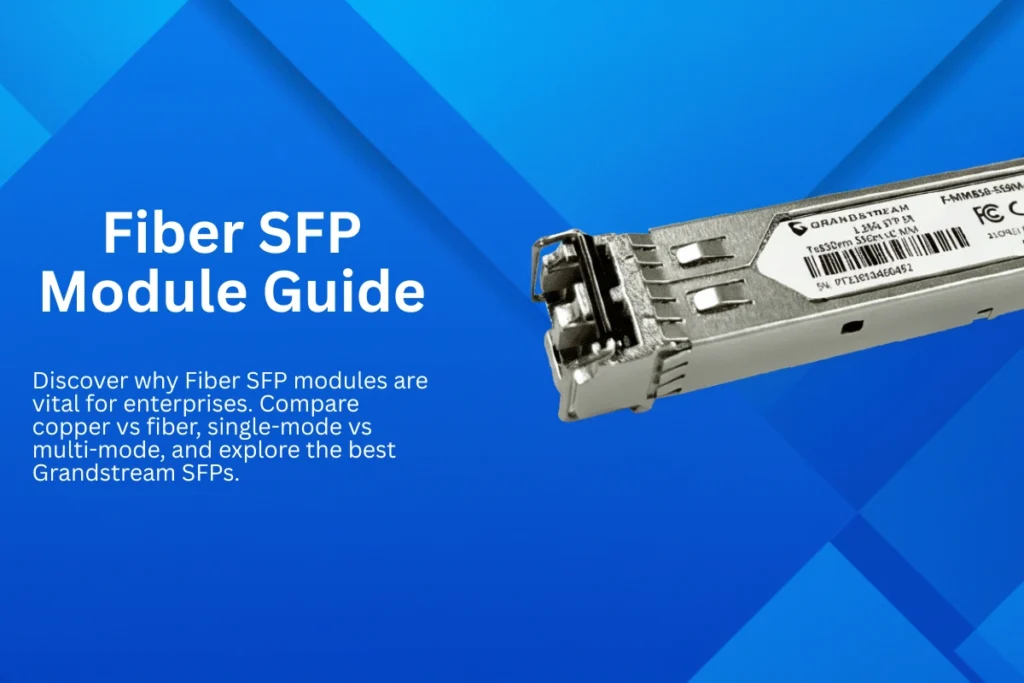As discussed in previous blogs, we all know or have an idea that enterprises rely heavily on unified communications (UC), the perfect merge of voices, video clarity, messaging options, and data across secure, protected networks. Whether you are doing conferencing with international teams or maintaining high-speed data transfers between branches, network performance is the backbone of this ecosystem. And at the core of this performance lies one small but powerful device that is the Fiber SFP module.
These compact, hot-swappable transceivers may look small, but they are critical for speed, reliability, and scalability in enterprise networks. For IT managers looking to upgrade their UC systems, Spoglink – your trusted partner for networking and VoIP hardware solutions provides enterprise-ready products.
In this guide, we’ll break down why Fiber SFP modules are essential, how they differ from copper SEPs, and which models are actually best suited for your business needs.
What is a Fiber SFP Module?
A Fiber SFP module, short for small form-factor pluggable, is a compressed transceiver that plugs into network switches, routers, or servers to allow fiber optic communication. It gives flexible network connectivity by allowing businesses to choose between fiber or copper interfaces depending on their requirements.
In simple terms, it acts like a bridge that helps in converting electrical signals into optical signals for fiber optic transceivers, guaranteeing fast and efficient data transfers across long ranges and distances.
Unlike other traditional types of built-in ports, SFPs are usually more modular and adaptable, which gives enterprises of different sizes the freedom to upgrade or change their network interfaces without replacing their entire pieces of hardware. If you want to check different options in Fiber Modules, or if you want to check a detailed description of our products, feel free to visit our website.
Copper SFP vs Fiber SFP: What’s the Difference?
One of the biggest questions IT managers face is whether to deploy copper SFPs or fiber SFPs. Both have their place in enterprise networking, but their performance and use cases differ significantly.

For businesses that are more towards adaptability, speed, and long-distance coverage communications, Fiber SFP modules are the top accessories to depend on. They are the backbone of UC infrastructure, To make sure the quality of calls is crystal clear, uninterrupted video meetings, and fast file transfers without any lagging or buffering.
Single-Mode vs Multi-Mode SFP Modules
Now comes the most common question that might come to any reader’s mind. So to make it easy to understand, we will break down the single-mode vs multi-mode SFP modules.
When choosing a fiber module, enterprises must decide between single-mode and multi-mode SFPs.
🔹 Single-Mode SFP
- Uses a narrow laser light beam.
- Supports extremely long distances — up to 100 km.
- Ideal for inter-building or inter-city connectivity.
- Example: Grandstream F-SM1310-10km-10G — perfect for enterprises that require 10G speeds over extended distances.
🔹 Multi-Mode SFP
- Uses multiple light paths in wider fiber cores.
- Supports shorter distances (up to 550m).
- Best for intra-building networks like large offices or campuses.
- Example: Grandstream F-MM850-550m-1.25G — designed for high-speed short-range connections.
By understanding single-mode vs multi-mode SFPs, IT managers can design customized UC networks that balance performance and cost.
Why Fiber SFP Modules Are Essential for Unified Communications
1. High-Speed Connectivity
UC systems demand real-time communication without lags or packet loss. A fiber optic transceiver provides lightning-fast data transfer, making video conferencing, VoIP calls, and collaboration tools easy.
2. Expandability for Enterprise Growth
Unlike fixed interfaces, small form-factor pluggable (SFP) modules are hot-swappable. Businesses can upgrade from 1G to 10G speeds without replacing expensive switches — ensuring future-proof investments.
3. Extended Distance Coverage
Whether it’s connecting different buildings in a corporate campus or linking data centers across cities, Fiber SFP modules provide the reach that copper simply cannot.
For example, the Grandstream F-SM1310-20km-1.25G allows enterprises to extend networks across 20 km without compromising performance.
4. Superior Reliability
Fiber connections are immune to electromagnetic interference (EMI) and signal degradation, ensuring consistent performance even in high-density office environments.
5. Cost-Effective in the Long Run
While fiber modules have higher upfront costs compared to copper, they offer better durability, lower maintenance, and reduced downtime — resulting in greater ROI.
Best Fiber SFP Modules for Enterprises in 2025
Here are some top picks tailored for enterprise corporate communications systems:
- Grandstream F-MM850-300m-10G
- Multi-mode, 10G speeds, 300m range.
- Perfect for data-heavy environments within large campuses.
- Multi-mode, 10G speeds, 300m range.
- Grandstream F-MM850-550m-1.25G
- Multi-mode, 1.25G speeds, 550m coverage.
- Affordable choice for short-range enterprise applications.
- Multi-mode, 1.25G speeds, 550m coverage.
- Grandstream F-SM1310-10km-10G
- Single-mode, 10G speeds, 10 km distance.
- Ideal for fast, long-distance communication between branches.
- Single-mode, 10G speeds, 10 km distance.
- Grandstream F-SM1310-20km-1.25G
- Single-mode, 1.25G speeds, 20 km coverage.
- A budget-friendly long-distance solution.
- Single-mode, 1.25G speeds, 20 km coverage.
Conclusion
The success of corporate unified communications depends on a robust, scalable, and future-ready network infrastructure. At the heart of this infrastructure lies the Fiber SFP module, enabling everything from seamless VoIP calls to lag-free video conferences and reliable data transfers.
By choosing the right single-mode or multi-mode SFP module, enterprises can future-proof their UC systems while maximizing ROI. Explore the complete collection of Fiber SFP Modules at Spoglink and empower your business with the speed and reliability it deserves. Or visit our Homepage for more enterprise networking solutions.

Spoglink: Where Smart Buyers Go for Smarter Gear
Join thousands who rely on us for quality, performance, and real support.





